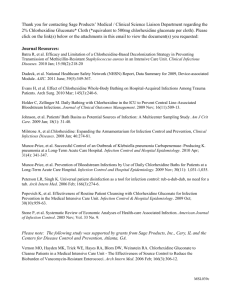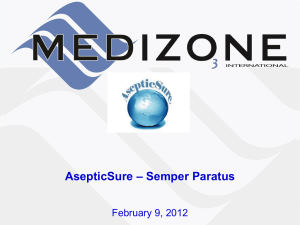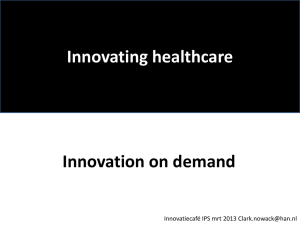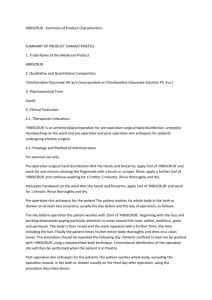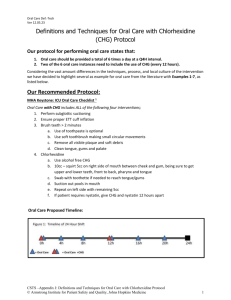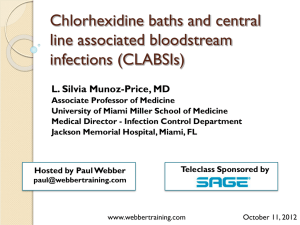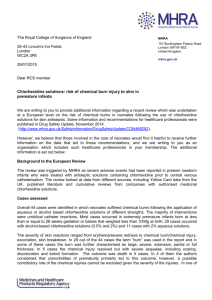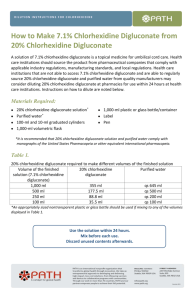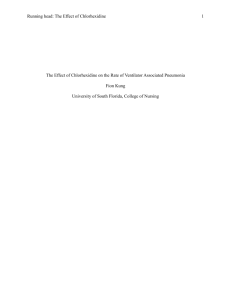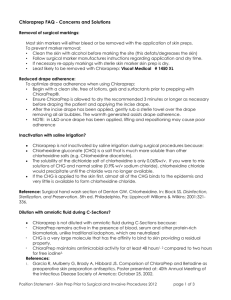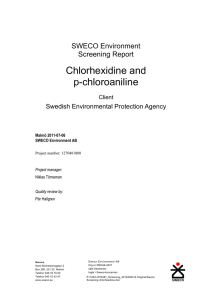04/04/2014 - inssec.org
advertisement
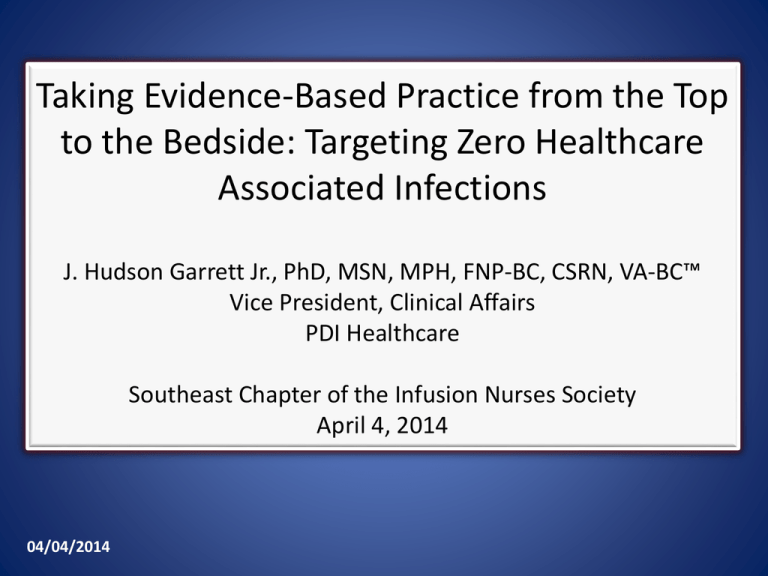
Taking Evidence-Based Practice from the Top to the Bedside: Targeting Zero Healthcare Associated Infections J. Hudson Garrett Jr., PhD, MSN, MPH, FNP-BC, CSRN, VA-BC™ Vice President, Clinical Affairs PDI Healthcare Southeast Chapter of the Infusion Nurses Society April 4, 2014 04/04/2014 Disclosures PDI Healthcare-Employee President, Board of Directors Vascular Access Certification Corporation Clinical Practice Committee PEDIVAN Second Author Vascular Access Core Curriculum Author Association for Vascular Access President, Board of Directors SE Chapter of the Infusion Nurses Society Board of Directors & Education Committee Chairperson Greater Atlanta Chapter Association for Professionals In Infection Control and Epidemiology Chairperson, Clinical Research Committee Association for the Healthcare Environment 04/04/2014 Objectives Discuss the implications of implementation of evidence-based practices on patient safety and prevention of Healthcare Associated Infections Review the pathways for clinical research from publication to implementation Discuss the critical research priorities for Vascular Access and strategies for clinician engagement 04/04/2014 If you can’t beat them, join them 04/04/2014 Question • How long does it take to fully implement an evidence based practice at the bedside? • Who is responsible for Evidence-Based Practice within your hospital? Unit? Etc.? 04/04/2014 What do these have in common? 04/04/2014 The Importance of a Checklist Is there tangible, outcomes-based value? 04/04/2014 Self Check “So with all of the evidence based practices that exist for the prevention of HAIs, why do most healthcare facilities fail to utilize these recommendations approximately 60% of the time?” Consumers Union 04/04/2014 WHO Checklist for Safer Surgical Care 04/04/2014 And then there was….. 04/04/2014 04/04/2014 Healthcare-Associated Infections (HAIs) 1 out of 25 hospitalized patients affected 772,000 HAI’s annually 75,000 deaths annually Associated with increased mortality Attributed costs: $26-33 billion annually HAIs occur in all types of facilities, including: Long-term care facilities Dialysis facilities Ambulatory surgical centers Hospitals 04/04/2014 How do you view mortality? 04/04/2014 Outbreaks vs. Endemic Problems Endemic problems represent the majority of HAIs Device-associated infections Procedure-associated infections Catheter-associated urinary tract infections (CAUTI) Central line-associated Blood stream infections (CLABSI) Ventilator-associated Pneumonia (VAP) Surgical site infections (SSI) Adherence problems Antimicrobial stewardship Hand hygiene Isolation precautions 04/04/2014 Changing Landscape of Healthcare Growing populations at risk Immunocompromised individuals Low birthweight, premature neonates Transplant recipients on immunosuppressive therapy Special environments Intensive care and burn units Infusion services 04/04/2014 Healthcare has moved beyond hospitals Hospitals Ambulatory Facilities Dialysis Facilities Urgent Care 04/04/2014 Challenges of Tomorrow Decreasing Reimbursement Evolving Technological Needs Resistant Microbes Antimicrobial Resistance Higher Acuity Staffing Transparency 04/04/2014 Public Reporting 04/04/2014 04/04/2014 04/04/2014 Fighting back against antibiotic resistance 04/04/2014 04/04/2014 How Does Transmission Occur? Contaminated Skin of the Patient Environmental Surfaces Patient Care Equipment 04/04/2014 Contaminated Hands of HCP & the Patient Physiology of the Skin Illustration of Cross-section of Human Skin • Skin is composed of two layers –epidermis & dermis • Bacterial flora are on and within the epidermis, hair follicles, sweat & sebaceous glands • Dermis and subcutaneous tissue are free of microbial flora 04/04/2014 Source: Snyder, O. Peter “A Safe Hands Hand Wash Program” Available at; http://www.h-tm.com/Documents/Safehands.htmll Accessed November 29, 2005. What is the goal of skin antisepsis? A. To make the skin sterile B. To make the skin clean C. To reduce the amount of microorganisms that are present on the skin D. To reduce the risk for infection from endogenous flora 04/04/2014 Trick Question • Is the skin sterile after you perform skin antisepsis? – Yes – No – Unsure? 04/04/2014 04/04/2014 Scenario • Research Question: Can you use CHG/IPA skin antiseptics on infants under two months of age? • Background: Previously CHG was contraindicated by the FDA for this use. • Results: Wait and see……EBP at work! 04/04/2014 The Debate of CHG in Neonates 04/04/2014 Skin Antiseptic Agents • Choice varies with age – Population based complications – < 2 months • EGA • Post natal age • Agents – 2 to 3.15% CHG - alcoholic formulation – CHG - aqueous formulation – Povidone iodine • Removal considerations – Normal Saline – Sterile Water 04/04/2014 04/04/2014 FDA Releases New Labeling 04/04/2014 Holistic Bundled Approach 04/04/2014 Summary of US Clinical Guidelines for Skin Antisepsis Organization and Guideline Skin Antisepsis Recommendations Centers for Disease Control and Prevention: Guidelines for the Prevention of Intravascular Catheter-Related Infections, 2011 www.cdc.gov Prepare clean skin with a >0.5% chlorhexidine preparation with alcohol before central venous catheter and peripheral arterial catheter insertion and during dressing changes. If there is a contraindication to chlorhexidine, tincture of iodine, an iodophor, or 70% alcohol can be used as alternatives. Category 1A Prepare clean skin with an antiseptic (70% alcohol, tincture of iodine, an iodophor or chlorhexidine gluconate) before peripheral venous catheter insertion. Category IB Infusion Nurses Society (INS): Infusion Nursing Standards of Practice, 2011 www.ins1.org Chlorhexidine solution is preferred for skin antisepsis. One percent to two percent tincture of iodine, iodophor, and 70% alcohol may also be used. Chlorhexidine is not recommended for infants under 2 months of age. Society for Healthcare Epidemiology of America (SHEA): Strategies to Prevent Central-Line Associated Bloodstream Infections in Acute Care Hospitals www.shea-online.org Use a chlorhexidine-based antiseptic for skin preparation in patients older than 2 months of age (A-I).43-46; Before catheter insertion, apply an alcoholic chlorhexidine solution containing a concentration of chlorhexidine gluconate greater than 0.5% to the insertion site. The Joint Commission: 2011 National Patient Safety Goals for Hospitals www.jointcommission.org Use an antiseptic for skin preparation during central venous catheter insertion that is cited in scientific literature or endorsed by professional organizations. Infectious Diseases Society of America (IDSA): Clinical Practice Guidelines for the Diagnosis and Management of Intravascular Catheter-Related Infection: 2009 Update by the Infectious Diseases Society of America www.idsociety.org Skin preparation for obtaining percutaneously drawn blood samples should be performed carefully, with use of either alcohol or tincture of iodine or alcoholic chlorhexidine greater than 0.5% CHG, rather than povidone-iodine;. Skin preparation with either alcohol, alcoholic chlorhexidine (>0.5%), or tincture of iodine (10%) leads to lower blood culture contamination rates than does the use of povidone-iodine. APIC Guide to the Elimination of Catheter-Related Bloodstream Infections, 2009 www.apic.org Although a preparation containing a concentration of alcoholic chlorhexidine gluconate greater than 0.5% is preferred, tincture of iodine, an iodophor, or 70% alcohol can be used. APIC Guide to the Elimination of Infections in Hemodialysis, 2010 04/04/2014 www.apic.org For patients older than 2 months, a skin preparation solution containing greater than 0.5% chlorhexidine gluconate and 70% isopropyl alcohol should be applied to the insertion site and allowed to dry before the skin is punctured. Errors Common to Organizational Change Allowance for complacency Failure to create a sufficiently powerful Guiding Coalition and Change Team Not truly integrating the vision Allowance for obstacles Not celebrating “short-term wins” Declaring victory too soon Neglecting to anchor changes firmly in the culture 04/04/2014 Shift Towards a Culture of Safety 04/04/2014 04/04/2014 37 Please Use CUS Words but only when appropriate! 04/04/2014 38 BRIDGING EVIDENCE-BASED PRACTICE GAPS 04/04/2014 Where do you even begin? 04/04/2014 State of prevention knowledge and science Guidelines developed for each type of infection and based on systematic reviews of medical literature Prevention of central line-associated blood stream infections Prevention of catheter-associated urinary tract infections Prevention of surgical site infections Prevention of healthcare-associated pneumonia Management of multidrug-resistant organisms Recommendations graded according to evidence Guidelines contain many recommendations Current efforts to help prioritize interventions that are most effective 04/04/2014 Adherence to infection control guidelines is incomplete Many HAIs are preventable with current recommendations Failure to use proven interventions is unacceptable Only 30%-38% of U.S. hospitals are in full compliance Just 40% of healthcare personnel adhere to hand hygiene Insufficient infection control infrastructure in nonacute care settings has allowed major lapses in safe care 04/04/2014 Local success fuels national prevention Regional Unit 04/04/2014 Facility National From Concept to Implementation Clinical Best Practice/Observation Evaluation of Hypothesis on Local Level Replication/Duplication Abstract/Poster Presentation Manuscript 04/04/2014 Wait, There’s more…. Additional Studies Conducted Guideline Development Guideline Dissemination Implementation Measurement of Outcomes/Evaluation 04/04/2014 Healthcare-associated Infection The need for HAI prevention research 04/04/2014 Prevented Need for complete implementation of practices known to prevent HAIs Need for ongoing research to identify new strategies to prevent the remaining HAIs Preventable Prevention Approach Unknown Formula for Success GOAL: ZERO HEALTHCARE ASSOCIATED INFECTIONS Infection Prevention Vascular Access Professionals Evidence-Based Practices Implementation 04/04/2014 Consumers Public Health Medical Professionals Safe Healthcare is Everyone’s Responsibility Patients Payors Government 04/04/2014 Healthcare Facilities Hypothetical ? • If you knew………………………. • That you could do something simple, easy, cost effective, and that was • Evidence-Based, but took a little extra time….. • Would you do it????? If it saved a life….. 04/04/2014 Questions • How will you approach Infection Prevention differently within your own practice setting? • Contact Information: – Email: hudsongarrettjr@gmail.com – Phone: 800-444-6725, ext. 8576 04/04/2014

